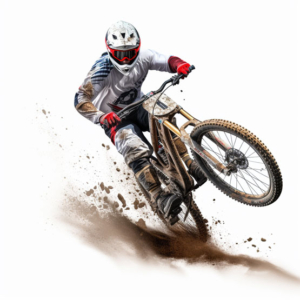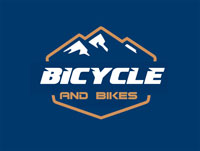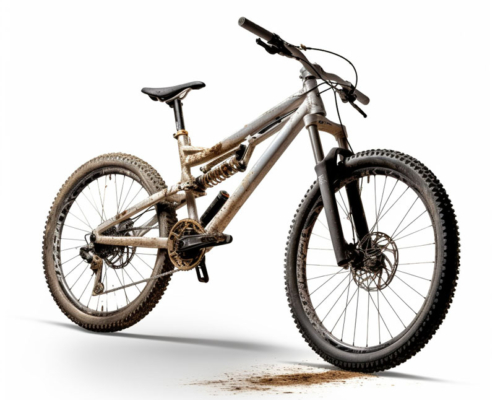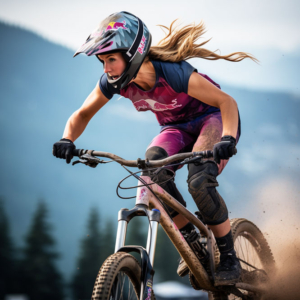Dirt Jump Bike
AKA Dirt Jumper or ‘DJ’ Bikes
What is a Dirt Jump Bike?
Dirt Jump bikes, often abbreviated as DJs, are specifically designed bicycles for riding and performing tricks on dirt mounds or specially built ramps.
Bridging the gap between BMX and mountain bikes, they combine features from both worlds to provide a unique riding experience tailored for jumps and stunts.
On this page you will find information about:
The Different Types of Dirt Jumper Bikes
Unique Features of Dirt Jumpers
Wheel and Tire Characteristics
Different Types of Dirt Jump Bikes
The world of dirt jumping is diverse, with different bike styles catering to specific terrains and riding preferences.
While they all share the same DNA—built for jumps and tricks—each style is uniquely tailored to its intended use, whether it’s racing down a track, performing aerial stunts, or mastering urban environments.
As with any cycling discipline, riders often choose their bikes based on personal preferences, the terrains they frequent, and their riding goals.
Traditional Dirt Jumpers
Primary Use
Suited for dirt jump parks, pump tracks, and street riding.
Features
Rigid frame with front suspension (typically with travel between 80mm and 140mm).
26-inch wheels.
Single-speed drivetrain.
Wide handlebars for better control.
Slopestyle Bikes
Primary Use
Designed for slopestyle competitions, where riders navigate a downhill course filled with jumps, drops, and other features.
Features
Full suspension, but with shorter travel (usually around 100mm to 130mm) to maintain bike’s playful nature.
Frame geometry tailored for aerial tricks and landings.
Often equipped with a single-speed drivetrain.
Lightweight construction for ease of handling in the air.
4X (Four Cross) Bikes
Primary Use
4X racing involves four riders racing down a purpose-built track filled with jumps, berms, and obstacles.
Features
Can be hardtail or full suspension. If full suspension, travel is typically shorter.
Might have a multi-speed drivetrain for better acceleration and speed control.
Robust frame construction to handle aggressive racing conditions.
Street/Park Bikes
Primary Use
Riding and performing tricks in urban environments or skateparks.
Features
Often hardtail, with either rigid forks or short-travel suspension forks.
Smoother tire tread for grip on concrete or wooden ramps.
Compact frame geometry for quick maneuvers and tricks.
Some models might lean closer to BMX bikes with 24-inch wheels and specific frame geometries.
Big Air Bikes
Primary Use
Built for massive jumps and big airtime.
Features
Typically full suspension with a bit more travel to handle large drops and jumps.
Reinforced frame construction.
Stability is a key focus, both for mid-air control and smooth landings.
Unique Features of A Dirt Jumper
Frame Geometry and Materials
Dirt jumper bikes, designed specifically for the demands of dirt jump riding, rely heavily on their frame geometry and material choice to ensure the bikes are both maneuverable and durable.
Let’s delve deeper into these aspects:
Frame Geometry
Low Slung Profile
Dirt jumper frames tend to have a more compact and low-slung design.
This allows riders to easily shift their weight, essential for performing aerial tricks.
Steep Head Angle
The head tube angle on DJs is usually steeper than that found on traditional mountain bikes.
This design choice provides quicker steering responses, ideal for navigating tight jump lines and making split-second adjustments in the air.
Short Chainstays
Shorter chainstays, the part of the frame connecting the rear wheel to the bottom bracket, enhance maneuverability, making it easier for riders to lift the front wheel and initiate spins.
Long Top Tube
A slightly extended top tube offers riders more room to move when performing tricks.
It also provides a more stable feel during flight, making landings more manageable.
Low Bottom Bracket
Positioned lower than traditional MTBs, the bottom bracket’s height on DJs ensures a low center of gravity, enhancing stability during jumps and stunts.
Materials
Chromoly Steel (CrMo)
Properties: Chromoly steel is a blend of chromium and molybdenum with steel. This alloy is often considered superior to standard steel due to its higher strength-to-weight ratio.
Advantages
Bikes made from CrMo are durable, absorb shocks effectively, and have a certain ‘springiness’ favored by many riders. They tend to be more forgiving on harsh landings compared to aluminum frames.
Aluminum
Properties: Aluminum is a lightweight metal that’s commonly used in bike manufacturing. It is typically stiffer than steel.
Advantages
Aluminum-framed DJs are usually lighter, which can be beneficial for certain tricks. They’re also resistant to rust, which can be an advantage in muddy or wet conditions.
Carbon Fiber (less common for DJs)
Properties: Carbon fiber is a composite material known for its high stiffness, strength-to-weight ratio, and moldability.
Advantages
While it’s rarer to find a DJ made of carbon due to its cost and the nature of the sport, such bikes would be incredibly lightweight. However, their durability under the rough conditions of dirt jumping is debated among riders.
Suspension Systems of Dirt Jump Bikes
Dirt jumper bikes typically utilize a suspension system, primarily in the front, to handle the hard impacts and stresses of jumping.
Understanding the suspension is crucial, as it plays a significant role in the bike’s performance, especially when landing after a jump.
Let’s look deeper into the characteristics and functionalities of these systems.
Front Suspension (Forks)
Travel
Dirt jumpers usually have front forks with a travel ranging from 80mm to 140mm.
The “travel” is the amount of movement the fork can compress.
The right amount of travel can vary based on rider preference, jump size, and type of riding.
Stiffness
DJ forks are stiffer than those on standard mountain bikes.
This rigidity ensures that the fork won’t compress too easily, especially during takeoff, which could negatively affect a jump.
Adjustability
High-end DJ forks often come with adjustability features.
Riders can alter the compression, rebound, and sometimes even the travel.
This allows customization based on rider weight, riding style, and trail conditions.
Materials
The stanchions (upper part of the fork) are usually made of materials like aluminum for lightweight and strength.
The lowers might be constructed from magnesium for its combination of lightness and durability.
Brake Mounts
Most DJ forks come with disc brake mounts, given that disc brakes are the standard for this type of riding due to their superior stopping power and modulation.
Rear Suspension
While most dirt jumper bikes are hardtails (meaning they have no rear suspension), there are full-suspension dirt jumper models, though they are less common.
Purpose
Rear suspension on a DJ bike aids in absorbing bigger impacts and provides additional control during landings.
However, they can make some tricks more challenging due to the added movement in the bike’s rear.
Travel
Rear travel on these bikes is typically shorter than on trail or downhill bikes, often ranging from 80mm to 120mm.
Shock Absorbers
Just like the forks, rear shocks come with adjustable settings.
Compression, rebound, and sometimes even the progression of the spring can be adjusted.
Considerations for Suspension Systems
Weight
Suspension systems, especially those with more travel and features, add weight to the bike.
Some riders might prioritize a lightweight setup, while others might be willing to compromise for more cushioning and control.
Maintenance
Regular maintenance is vital.
Dirt, debris, and regular wear and tear can affect suspension performance.
Regular cleaning, seal checks, and occasional oil changes can prolong the life of the suspension.
Cost
High-end suspension systems, with more adjustability and features, come at a premium.
However, for many riders, the investment is justified by the enhanced performance and longevity they offer.
The suspension system on a dirt jumper bike plays a crucial role in ensuring optimal performance during jumps and landings.
While the front suspension is almost a standard, rear suspension varies based on rider preference and the intended style of riding.
Regular maintenance and a proper understanding of the system’s adjustability can significantly improve the overall riding experience.
Wheel and Tire Characteristics of Dirt Jump Bikes
The wheels and tires of dirt jumper bikes are critical components, providing stability, grip, and resilience to the varied demands of dirt jumping.
Unlike standard road bikes or even some MTBs, the wheels and tires of dirt jumpers are constructed to endure the rough nature of the sport while maintaining optimal performance.
Here are the characteristics of these elements.
Wheel Size
24-inch Wheels
These are closer to BMX sizes and offer greater maneuverability, making them ideal for technical tricks and tight courses.
However, they might not roll over obstacles as smoothly as larger wheels.
26-inch Wheels
More common in dirt jumpers, these wheels strike a balance between agility and stability.
They roll over obstacles with greater ease and maintain momentum better than their smaller counterparts.
Rim Construction
Materials
Most dirt jumper rims are made of aluminum alloys, which offer a good balance between weight and strength.
Aluminum is both lightweight and able to withstand the stresses of landing jumps.
Width
Dirt jumper rims tend to be wider than typical MTB rims.
The additional width provides a broader base for the tire, enhancing stability and grip.
Strength
Many DJ rims are double-walled for added strength and durability.
This construction helps the wheel endure hard landings and impacts without denting or getting out of true.
Tire Characteristics
Width
DJ tires are typically wider, often ranging between 2.1 to 2.5 inches (or even more).
The wider profile offers better cushioning upon landings and improved grip on dirt surfaces.
Tread Pattern
Dirt jumper tire treads are designed to provide optimal grip on dirt surfaces.
While some have low-profile knobs for hard-packed dirt, others might have more aggressive treads for looser conditions.
Sidewalls
Reinforced sidewalls are common in DJ tires.
A strong sidewall helps resist pinch flats (when the tube gets pinched between the rim and the tire, causing a puncture) and provides additional support during side loads, as when landing at an angle.
Rubber Compound
The rubber’s hardness can vary.
Softer compounds provide better grip but tend to wear out faster, while harder compounds are more durable but might not grip as well.
Tube vs. Tubeless
While most dirt jumpers still use traditional tubes, there’s a growing trend of riders opting for tubeless setups.
Going tubeless can reduce the risk of pinch flats and allows riders to run lower tire pressures for better grip and shock absorption.
Considerations for Wheel and Tire Selection
Riding Style
Riders who emphasize technical tricks might prefer different wheel and tire setups than those focusing on big air jumps.
Local Terrain
The type of soil, whether it’s loose and sandy or hard-packed, can influence tire choice.
Maintenance
Regularly checking tire pressures, inspecting for damage, and ensuring wheels are true (not wobbly or bent) is crucial for optimal performance.
Wheels and tires are foundational to the dirt jumping experience.
Their construction, size, and design characteristics directly influence the bike’s handling, stability, and resilience.
As with all aspects of the sport, personal preference plays a pivotal role, so riders often experiment with different setups to find the perfect fit for their style and local terrain.
Drivetrain and Braking Systems of Dirt Jump Bikes
Dirt jumper bikes are specialized for airborne tricks and navigating through challenging dirt tracks, which demands unique drivetrain and braking requirements.
Here’s an in-depth look into these components and their specificities in the context of dirt jumping.
Drivetrain
Single Speed
Most dirt jumper bikes operate on a single-speed drivetrain.
This simplicity is favored because there’s no need for shifting gears when the primary focus is on jumps.
It also reduces the weight and potential points of failure.
Chain Tensioners
Given the hard landings and aggressive riding style, chain slap or derailment can be a concern.
Many dirt jumpers employ chain tensioners or guides to ensure the chain remains in place.
Crankset
The crank arms on dirt jumpers are typically more robust and shorter than those on standard MTBs.
Shorter cranks offer more ground clearance, reducing the risk of pedal strikes when cornering.
Bottom Bracket
Many DJs use a mid or Spanish bottom bracket, which provides a balance between strength and weight.
These are more robust and suitable for the rigors of dirt jump riding.
Pedals
Flat pedals are the norm in dirt jumping, allowing riders to easily take their feet off and put them back on during tricks.
These pedals often have pins for additional grip.
Braking Systems
Disc Brakes
Almost all modern dirt jumper bikes are equipped with disc brakes due to their superior stopping power, especially in muddy or wet conditions.
They also offer better modulation, allowing riders to adjust their speed with precision.
Hydraulic vs. Mechanical
Hydraulic disc brakes use fluid to transfer force from the lever to the caliper, providing more potent and consistent stopping power.
Mechanical disc brakes use a cable, are simpler, and easier to maintain but might not offer the same level of performance as hydraulic brakes.
Rotor Size
DJs often feature rotors in the range of 160mm to 180mm.
The rotor size impacts the braking force, with larger rotors offering more stopping power.
Brake Levers
Given the nature of dirt jumping, riders might opt for shorter brake levers, which can be operated with a single finger.
This setup provides more control over the handlebars while still being able to brake efficiently.
Rear Brake Priority
Some riders prefer only to have a rear brake on their dirt jumper to reduce weight and simplify their setup.
This choice is often sufficient for the demands of the sport.
However, having both front and rear brakes offers maximum stopping power when needed.
Maintenance and Upkeep
Regular Checks
It’s crucial to frequently inspect the drivetrain for signs of wear or damage. Chains, in particular, should be checked for stretching or damaged links.
Brake Maintenance
Brake pads need to be inspected for wear and replaced as necessary. Hydraulic systems should be bled periodically to maintain optimal performance.
Cleaning
After sessions, especially in muddy conditions, both the drivetrain and brakes should be cleaned to prevent dirt buildup and ensure longevity.
The drivetrain and braking systems on dirt jumper bikes are tailored to meet the unique challenges of the sport.
While their designs prioritize simplicity and durability, regular maintenance ensures consistent performance and longevity.
As riders push the boundaries of what’s possible in the air and on dirt, these components play a pivotal role in ensuring safety, control, and overall riding enjoyment.
Dirt Jump Bike vs. BMX vs. MTB
Origins and Evolution of Each Bike Type
While BMX bikes originated in the early 1970s as a means for kids to emulate motocross racing, MTB, or mountain bikes, emerged as off-road alternatives to traditional road bikes.
Dirt jumpers are a more recent development, blending the strengths of both.
Key Differences and Similarities
While BMXs are typically smaller with 20-inch wheels, dirt jumpers often sport 24 to 26-inch wheels.
MTBs come in a range of sizes and are designed primarily for off-road terrains.
Dirt jumpers, however, emphasize a sturdy frame, often with front suspension, for maximum aerial performance.


